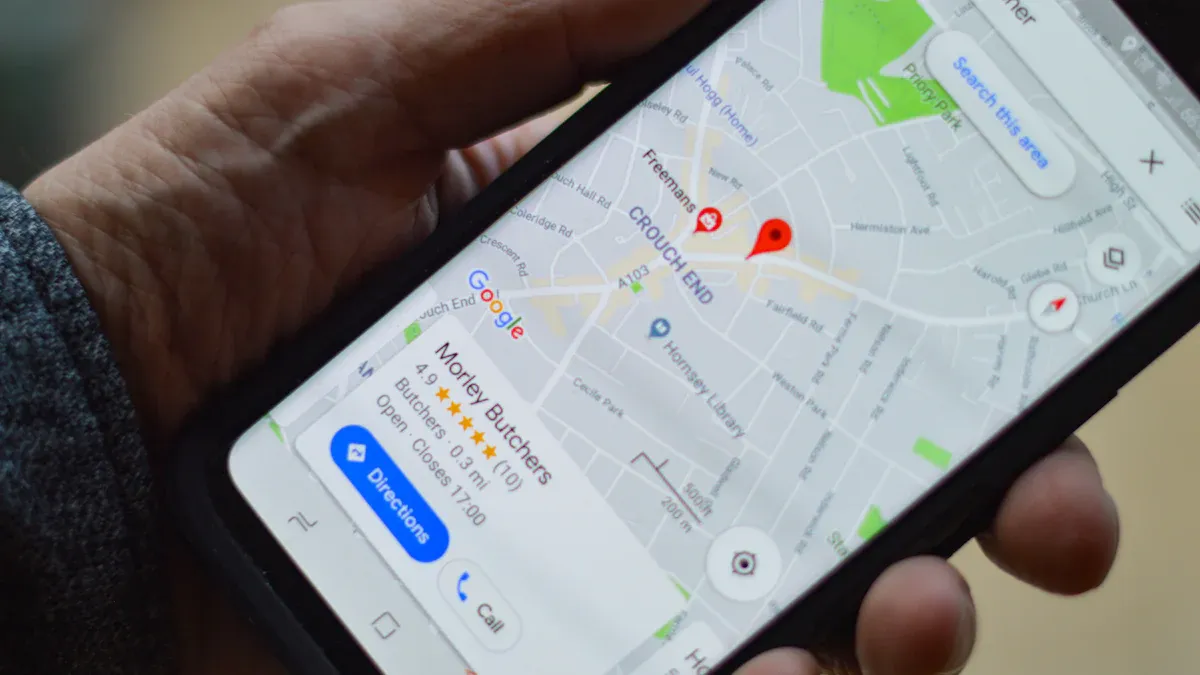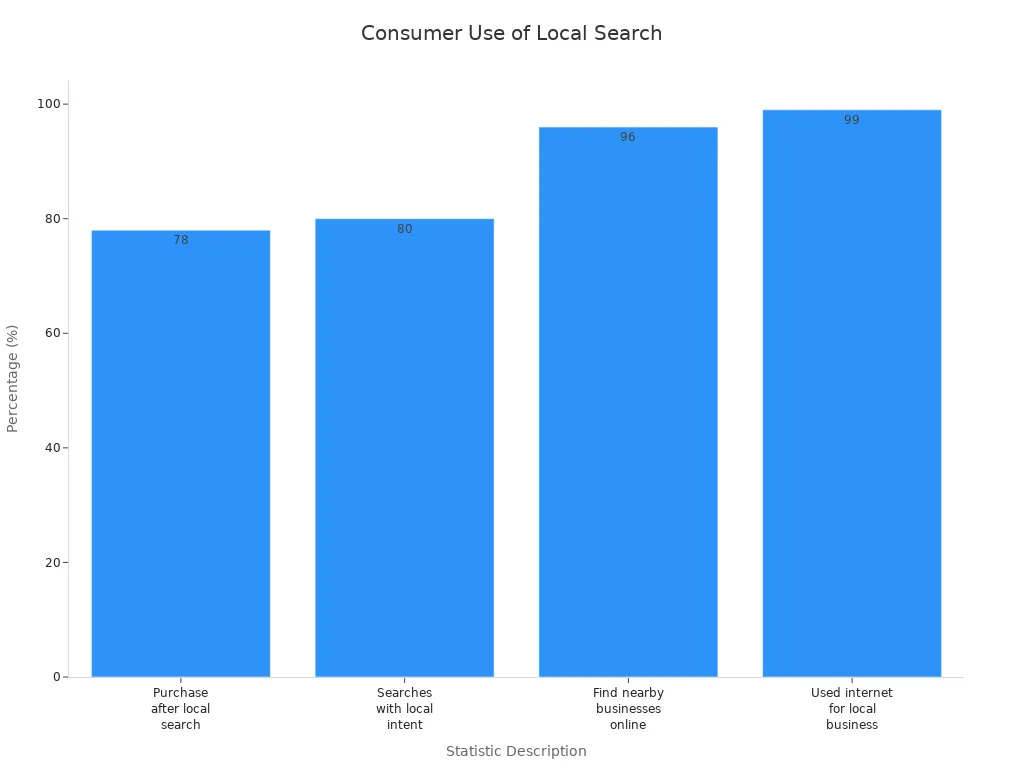Unlock Local SEO Research with a Proven Step Process

If you want to grow your business locally, you need a proven step process for Local SEO Research. By targeting the right local keywords, you can boost your search rankings and attract more customers. Businesses that rank at the top for local keywords often see click-through rates as high as 33%. Local SEO helps you appear in searches like “near me,” which brings more people to your website and store. When you optimize your online presence with local seo, you reach your target audience and increase trust. A clear local seo process makes it easier to turn searches into sales.
Why Local SEO Matters

Local Search Impact
You live in a world where people use their phones and computers to find what they need nearby. Local SEO helps you show up when someone searches for a product or service in your area. Almost half of all Google searches have local intent, which means people want results close to them. You can see how important this is for local businesses:
- 46% of Google searches focus on local results.
- 42% of users click on results in Google’s local pack.
- 80% of U.S. consumers search for local businesses every week.
- There are over 800 million monthly searches with “near me” in the U.S.
When you use local SEO, you make it easier for people to find your business online and visit your store. In fact, 51% of smartphone users visit a store within 24 hours after a local search. Google Search and Google Maps are the top platforms for local searches, so optimizing your presence there is key. The Google Local 3-pack appears in 93% of local intent searches, giving you a big chance to attract local customers.

Business Benefits
Local SEO does more than boost your online visibility. It helps you turn searches into real sales. Local search queries convert at rates up to twice as high as non-local searches. For example, 28% of “near me” searches lead to a purchase, and 88% of people visit or call a business within 24 hours after a local search on their smartphone.
| Statistic Description | Percentage / Ratio |
|---|---|
| People who search locally and end up making a purchase | 78% |
| Users conducting searches with local intent | 4 out of 5 (80%) |
| People who find out about nearby businesses via online search | 96% |
| People who have used the internet to look up local business | 99% |
You can measure the impact of local SEO by tracking website views, user actions, and in-store visits. Many local businesses see a rise in foot traffic and sales after improving their local SEO. For example, a family-owned bakery saw a 45% increase in visitors within three months. Local SEO also builds trust. When your business appears in local search results with good reviews, people are more likely to choose you over competitors. This trust leads to repeat business and higher revenue for small businesses.
Tip: Accurate and complete Google Business Profile listings get 7 times more clicks and are 70% more likely to attract physical store visits.
Local SEO Research Steps

A proven local SEO research process helps you find the best keywords and strategies for your business. Follow these steps to build a strong foundation for your local SEO success.
Core Business Terms
Start your local keyword research by listing the main terms that describe your business. These core business terms help you understand what services or products you offer and how people search for them. Use a table to organize these terms and their meanings:
| Term | Explanation |
|---|---|
| Brick-and-mortar store | Physical location where customers visit; important for NAP consistency in listings and maps. |
| Citation | Online mention of business name, address, phone number; crucial for credibility and local search rankings. |
| Local Listing | Online profile with business details on platforms like Google My Business; consistency improves local SEO. |
| Local SEO | Strategy to optimize online presence for local search results, enhancing visibility and foot traffic. |
| Local 3-Pack | Top three local businesses shown in Google search results with map; indicates local search prominence. |
| Call to Action (CTA) | Prompts encouraging user engagement (e.g., 'Call Now'); drives conversions and interaction. |
| Conversion | Desired user action such as purchase or contact form submission; key performance indicator. |
| Conversion Rate | Percentage of visitors completing desired actions; measures campaign effectiveness. |
| Keyword Research | Process of identifying relevant keywords considering competition and search volume; foundational for targeting local search queries. |
| Online Reputation Management (ORM) | Managing online reviews and mentions to maintain a positive image; impacts trust and local rankings. |
| User Experience (UX) | Overall ease and satisfaction of website interaction; influences engagement and local search performance. |
| User Generated Content (UGC) | Content created by customers like reviews and testimonials; builds authenticity and social proof. |
| User Intent (Local) | Understanding local searcher goals to tailor content and SEO strategies effectively. |
You can use these terms as the base for your keyword research. For example, a bakery might start with words like "bakery," "cakes," "pastries," and "custom cakes." This step helps you create a comprehensive list of localized keywords that match your business.
Location Modifiers
Next, add location modifiers to your core business terms. Location modifiers are words like city names, neighborhoods, or landmarks. They help search engines connect your business to a specific place. This step is key for local SEO research and helps you reach people searching for services near them.
- Location modifiers in keywords and metadata help search engines link your business to your area.
- Geo-modified keywords, such as "bakery in Brooklyn" or "best pizza near Central Park," match local intent search queries and increase click-through rates.
- Add geographic terms to title tags, meta descriptions, headers, and content for better local relevance.
- Use Google Maps and schema markup on your location pages to boost your local SEO.
- Create hyperlocal content about neighborhoods or events to attract more local traffic.
- Optimize for voice search by using conversational geo-modified keywords, like "Where is the nearest bakery?"
Tip: Local backlinks and partnerships with other local businesses can strengthen your local SEO signals.
Local Keyword Research Tools
To build a comprehensive list of localized keywords, use a mix of free and paid keyword research tools. These tools help you find what people search for in your area and how often they search for it.
- Google Business Profile: Manage your local listings and reviews. It is essential for local SEO visibility.
- Semrush Local: Offers keyword research, citation management, and review tracking.
- BrightLocal and Moz Local: Focus on citation and review management to improve your local search presence.
- Ahrefs: Provides keyword and competitor analysis to find local keyword opportunities.
- Whitespark: Tracks local rankings and monitors your local search performance.
- LocalFalcon: Analyzes keywords for very specific geographic areas.
- Places Scout: Tracks local rankings and competitor performance.
- Google Ads Keyword Planner: Gives accurate local keyword volume data.
- GrowthBar: Suggests local keywords, checks keyword difficulty, and analyzes competitors.
| Tool | Accuracy Features | Usability Features | Drawbacks Affecting Usability or Accuracy |
|---|---|---|---|
| Ahrefs | Large keyword database, keyword difficulty, click-through data, local search volume, competitor analysis | Local filtering, detailed metrics, content gap analysis | Expensive, steep learning curve for beginners |
| SEMrush | Comprehensive keyword data, keyword difficulty, local rank tracking, competitor insights | User-friendly interface, extensive tutorials | Paid tool, advanced features can be complex |
| BrightLocal | Local rank tracking, citation management, local search audits | Focused on local SEO, straightforward dashboards, white-label reports | Less extensive keyword data than broader tools |
| Moz Local | Local listings management, keyword tracking, citation accuracy insights | Purpose-built for local SEO, combines listings and keyword tracking | Lacks broader SEO features, paid tool but more affordable |
| Google Business Profile | Real consumer search query data, direct impact on local visibility | Free, integrated with Google ecosystem | Limited to existing traffic-driving queries, no extensive new keyword suggestions |
| Google Keyword Planner & Google Trends | Foundational keyword data, accessible and free | Basic usability, accessible to all users | Lack granularity and precise local focus |
Try different keyword research tools to find the best fit for your business. Use them to discover new localized keywords and track your progress.
Competitor Analysis
Analyzing your competitors is a vital part of local SEO research. You can learn which keywords help them rank high and find gaps in your own keyword strategy.
- Identify top competitors by checking who ranks in the top 10 for your target keywords.
- Use keyword research tools like Ahrefs and SEMrush to analyze their keyword rankings and backlink profiles.
- Run a keyword gap analysis to find keywords your competitors rank for but you do not.
- Audit their backlinks and local citations to discover new link-building opportunities.
- Check their Google Business Profile for completeness, including images, reviews, and ratings.
- Evaluate their on-page SEO, such as schema markup and website speed.
- Research which local directories list your competitors.
- Monitor their rankings regularly to spot new opportunities.
- Study their content strategy, including blog topics and posting frequency.
- Investigate their conversion funnels, social media, and local partnerships.
Note: Reverse engineering successful competitor tactics can help you improve your own local keyword research and local SEO.
Prioritizing Keywords
After building a comprehensive list of localized keywords, you need to prioritize them. Focus on keywords that match your business, have good search volume, and are not too hard to rank for.
Successful businesses optimize their Google Business Profile and website with location-specific keywords. They use these keywords in business names, categories, addresses, reviews, photos, FAQs, and hours. On websites, they add keywords to URLs, title tags, meta descriptions, headers, and body content. For businesses with more than one location, they create separate landing pages for each area with unique content.
Balance your keyword strategy by mixing high-volume keywords with long-tail keywords. Long-tail keywords have lower search volume but higher intent and are easier to rank for. For example, "emergency plumber in Queens" is more specific and less competitive than "plumber." As your site gains authority, you can target higher-volume keywords.
Use keyword research tools to check search volume and competition. Analyze your competitors’ keywords to find new opportunities. Place your prioritized keywords in important spots on your website and Google Business Profile to boost your local SEO.
Local SEO Keyword Research and Intent
Aligning your local SEO keyword research with user intent is crucial. You want to know what your customers are looking for and why. This helps you create content that matches their needs and increases your chances of turning visitors into customers.
| Metric Type | Evidence Description |
|---|---|
| Keyword Research Tools | Use tools like SearchAtlas Keyword Researcher and Google Trends to understand local search behavior. |
| Local Forums & Boards | Analyze local community language to tailor your content. |
| Organic Traffic Increase | Example: "Boiler repair Long Island" increased organic traffic by 30%. |
| Conversion Rates | Track conversions from local keywords to measure effectiveness. |
- Discover long-tail local keywords that reflect what people in your area want.
- Use local language and search behavior in your content to connect with your audience.
- Align your content with the customer journey, from awareness to decision.
- Place keywords in page titles, meta descriptions, headers, and body content.
- Regularly update your content to stay relevant and target new keywords.
For example, use transactional keywords like "book a haircut appointment" or "emergency plumber near me" to attract customers ready to buy. Use informational keywords like "how much does estate planning cost" to educate and build trust. Navigational keywords help people find your business, while commercial keywords like "best restaurants in New York" help you stand out in reviews and comparisons.
Tip: Track your results using Google Analytics and Google Business Profile Insights. Measure organic traffic, conversions, and keyword rankings to see what works best.
By following these steps, you can build a strong local keyword strategy. This approach helps your local business appear in more hyperlocal searches, attract more customers, and grow your presence in your community.
Content and Profile Optimization
Website Optimization
You can boost your local seo by making your website easy for both users and search engines to understand. Start by grouping your local keywords by topic and mapping each group to a specific page. This helps you avoid keyword cannibalization and makes your site more organized. Place your keywords in important spots like title tags, meta descriptions, headers, and throughout your content. Make sure each page answers the search intent behind the keywords.
- Add structured data markup to your pages. This helps search engines display rich results, which can make your business stand out in local search.
- Build internal links between related pages. These links guide visitors and help search engines see how your pages connect.
- Keep your internal links relevant and purposeful. A strong site structure improves user experience and supports your local seo goals.
Tip: Use AI tools to speed up content creation and improve quality. Create dedicated landing pages for each location you serve.
Regularly check your website’s performance in local search results. Adjust your keyword strategy as needed to keep your content fresh and relevant.
Google Business Profile
Optimizing your Google Business Profile gives your business a big advantage in local seo. Verified and complete profiles appear more often in Google Search and Maps, especially in the local pack. Businesses with optimized profiles are 70% more likely to get visits and 50% more likely to make a sale.
Follow these steps to get the most from your profile:
- Verify your Google Business Profile to show you are a real and trustworthy business.
- Fill out every detail, including business hours, address, and contact information.
- Use relevant keywords in your business description and services.
- Engage with customers by responding to reviews and answering questions.
- Keep your information consistent across all online directories.
- Use Google Business Profile insights to track what works and improve your strategy.
Customer reviews play a big role in local seo. Recent and positive reviews show that your business is active and reliable. Responding to all reviews, even negative ones, builds trust and signals to Google that you care about your customers. Businesses with more high-quality reviews often appear in the Google Map Pack, which gets the most clicks from local searches.
Note: Focus on excellent customer service to encourage more positive reviews. This will help your business stand out and attract more local customers.
Troubleshooting Local SEO
Common Pitfalls
You may face several challenges when working on local SEO. Many small businesses run into the same issues, which can hurt your visibility in local search results. Here are some of the most common pitfalls:
- Ignoring technical SEO, such as slow site speed, broken links, and poor site structure. These problems make it hard for search engines to index your site.
- Overusing location keywords, which can make your content look spammy and lower its quality.
- Forgetting about keyword research. Without it, you may target the wrong audience or miss valuable opportunities.
- Failing to optimize your Google Business Profile and not managing online reviews. This can lead to missed customer engagement and lower trust.
- Having inconsistent Name, Address, and Phone number (NAP) information across platforms. This confuses both search engines and customers.
- Not creating local content that connects with your community. You miss chances to improve your relevance in local searches.
- Neglecting mobile optimization. Most users search on mobile devices, so a poor mobile experience can drive them away.
Tip: Regularly check your website for technical issues like missing alt tags, duplicate content, or broken links. These problems can lower your rankings and hurt user experience.
Staying Updated
Local SEO changes often. Search engines update their algorithms throughout the year to improve how they show local search results. You need to stay alert and adapt your strategy to keep your rankings strong.
- Optimize your Google Business Profile, on-page SEO, citations, and reviews often.
- Monitor major updates, such as mobile-first indexing and spam-fighting changes.
- Use tools like Google Search Console, local rank trackers, and review management software to track your performance.
- Join SEO communities to learn about new trends and updates.
- Run regular SEO audits to catch and fix problems early.
- Diversify your online presence so you do not rely on just one channel.
- Focus on quality content and follow E-E-A-T principles: Experience, Expertise, Authoritativeness, and Trustworthiness.
Customer reviews play a big role in your local SEO. Search engines look at the number, quality, and freshness of your reviews. Ask for feedback and respond to reviews to build trust and improve your rankings. Good reviews also help you stand out in keyword research and attract more customers.
Note: Make keyword research a regular habit. Trends and search behavior change, so updating your keywords helps you stay ahead of competitors.
Following a proven step process for local SEO research helps you reach more local customers and grow your business. You can see real results, such as:
- Better rankings in local search and Google Maps
- More website visits from people in your area
- Higher customer engagement, like calls and direction requests
- Increased foot traffic and sales
When you keep refining your local SEO strategy, you build trust, attract more qualified leads, and stay ahead of changes in search trends. Treat SEO as an ongoing effort, and you will see steady growth over time.
FAQ
What is the most important step in local SEO research?
You need to find the right local keywords for your business. This step helps you reach people in your area who want your products or services. Use keyword tools and check what your competitors target.
How often should you update your local SEO keywords?
You should review your keywords every few months. Search trends change, and new competitors appear. Regular updates help you stay ahead and keep your business visible in local searches.
Do reviews affect your local SEO ranking?
Yes, reviews play a big role. Positive and recent reviews show search engines that your business is active and trusted. Respond to all reviews to build trust and improve your ranking.
Can you do local SEO without paid tools?
You can use free tools like Google Business Profile, Google Trends, and Google Keyword Planner. These tools help you find keywords and track your progress. Paid tools offer more features, but you can start with free options.
Why does NAP consistency matter for local SEO?
NAP stands for Name, Address, and Phone number. You need to keep this information the same everywhere online. Search engines trust your business more when your details match across all platforms.
See Also
Step-By-Step Process To Conduct A Thorough SEO Audit
Understanding The Business Advantages Of Performing SEO Audits
Effective Strategies To Improve Your Search Engine Rankings

